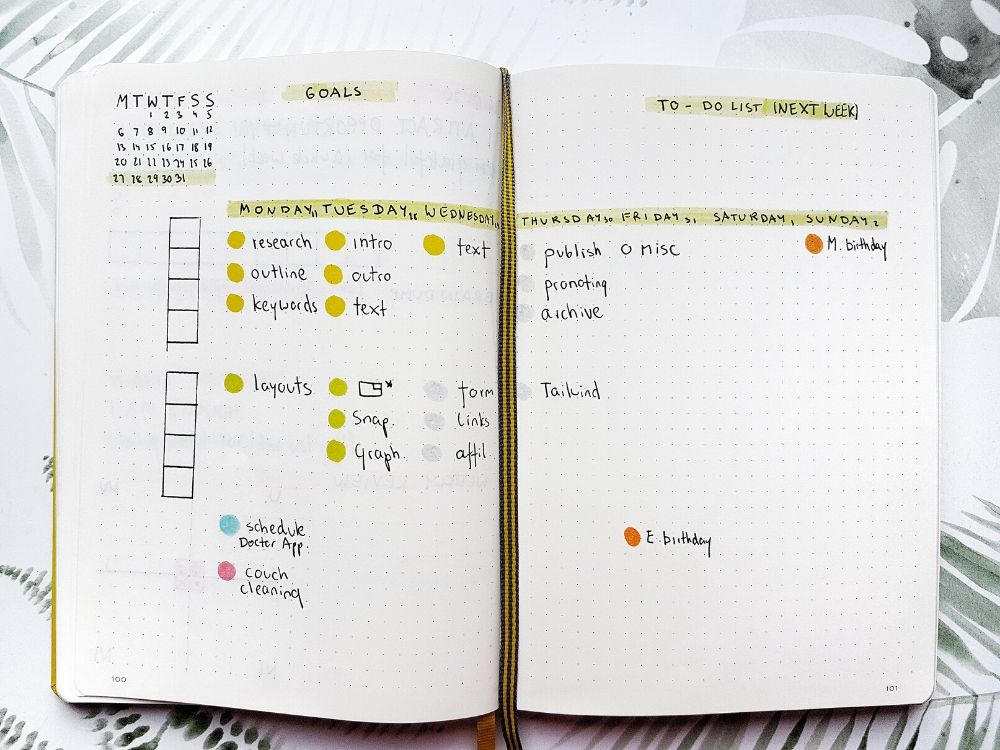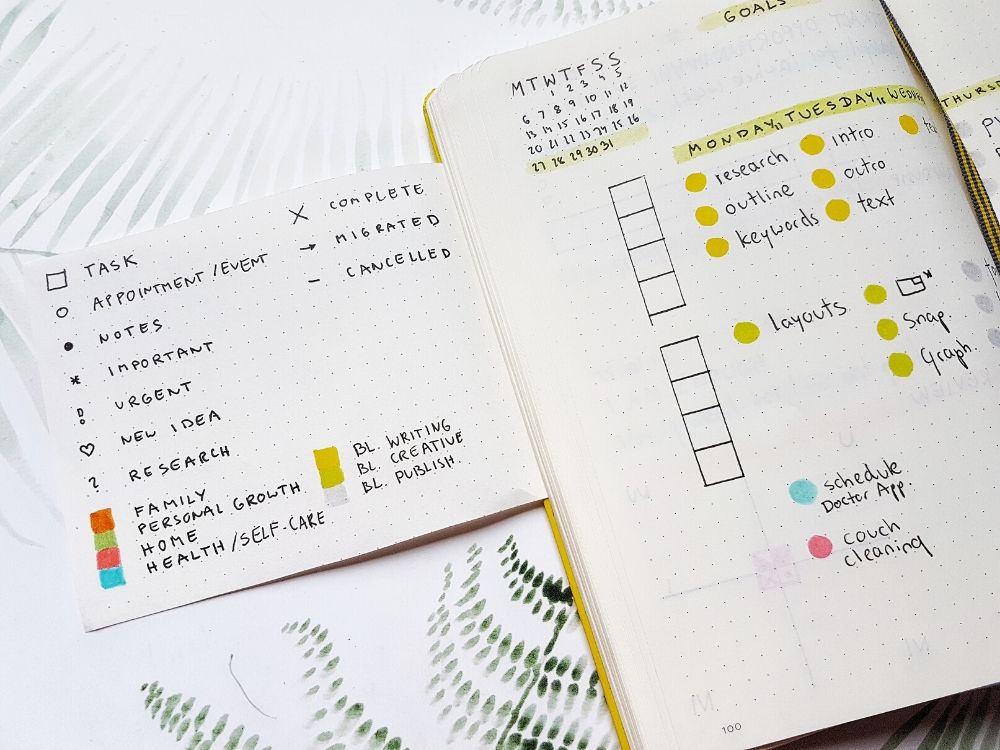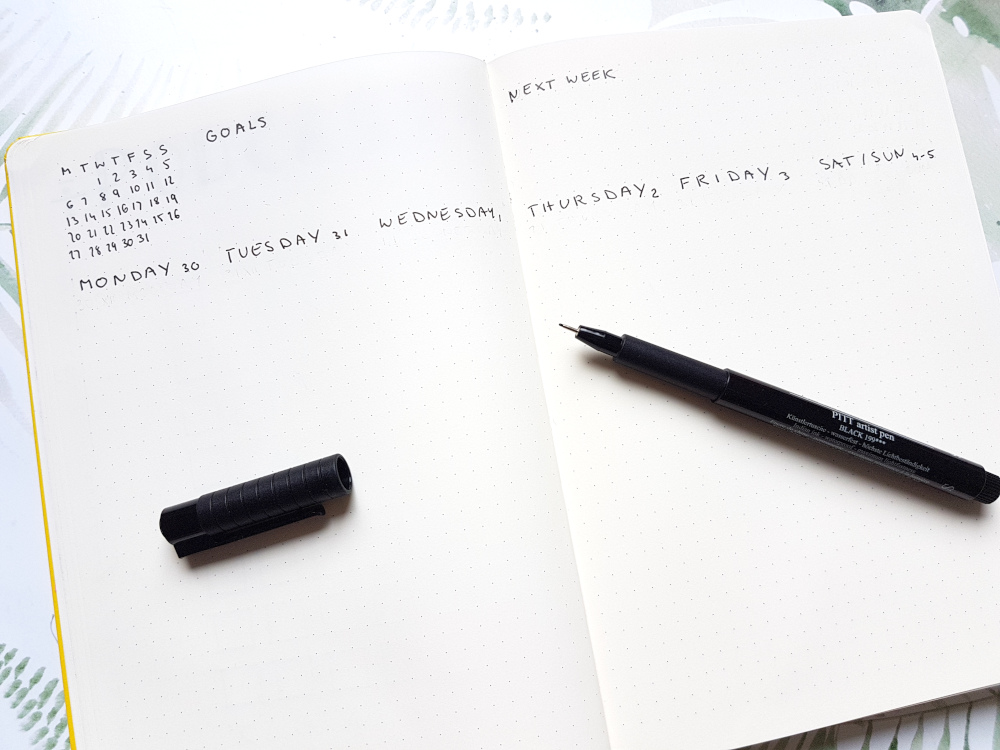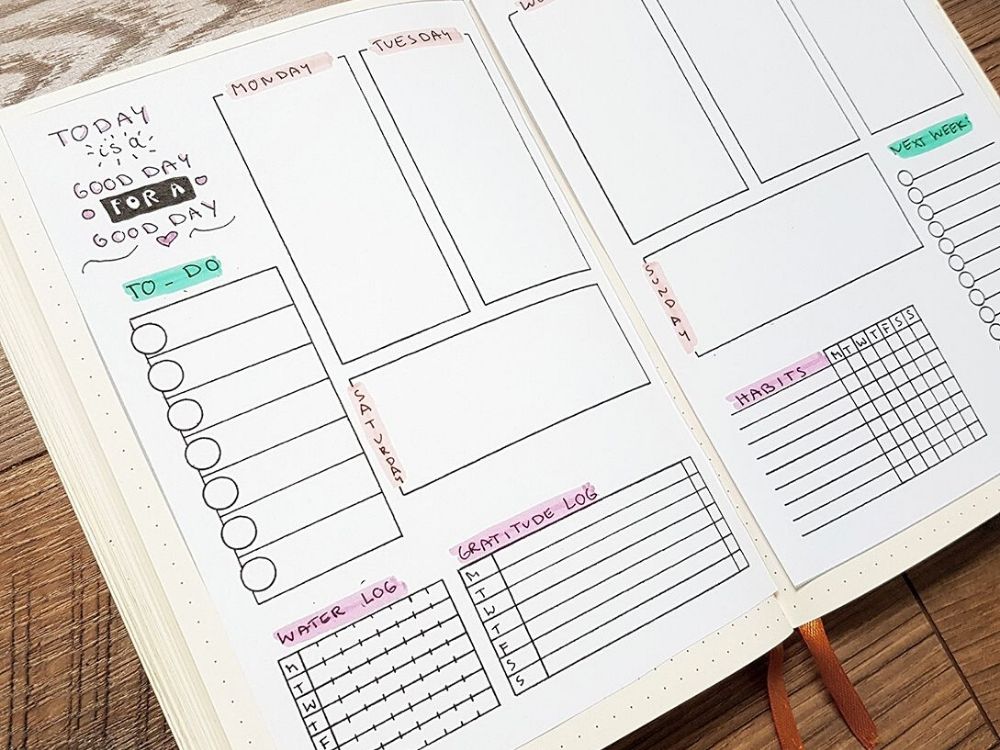Today you’re going to learn how to set up a minimalist bullet journal weekly spread ideas.
It’ll help you:
- plan and organize an entire week (even if your schedule is crazy busy)
- stay focused on your main goals
- set weekly priorities
- to stop overloading your to-do list
- relieve stress and anxiety
- estimate time for specific tasks
- avoid procrastination
- make time for self-care
In fact, keeping a weekly bullet journal helped me create a schedule without getting completely overwhelmed, avoid freaking out about my never-ending list of tasks I wish to accomplish, and deal with a feeling of being stressed out about my long to-do list.
So if you struggle with planning your week ahead, then you’ll love this step-by-step guide on how to create minimalist bullet journal weekly spreads.
[toc]
This post may contain affiliate links. As an Amazon Associate, I earn from qualifying purchases. It means that I may receive a commission if you click a link and purchase a product that I have recommended. It won’t cost you any extra money.
Minimalist Bullet Journal Weekly Spreads Not Only For Students
[mv_create key=”106″ type=”list” title=”Minimalsit Bullet Journal Weekly Spread Ideas” thumbnail=”https://anjahome.com/wp-content/uploads/2020/09/minimalist-bujo-weekly-spread.jpg”]
What is Bullet Journal Weekly Spread
Generally, a weekly spread allows you to have all tasks, events, appointments, reminders, notes, etc. gathered in one place.
In case, you’re wondering what the difference between setting up a weekly journal and a daily planner is, here are some pros and cons of weekly planning pages.
The Top Pros of Bullet Journal Weekly Layout (vs. Daily Logs)
- you have a weekly overview at hand
- you know immediately how the schedule for the next days looks
- it’s easier to plan your week or weeks ahead than within a daily log
The Top Cons of Bullet Journal Weekly Layout (vs. Daily Logs)
- due to limited space, sometimes it’s hard to fit everything (like daily notes, and ideas) in.
- you don’t have a place to break your big tasks into smaller steps.
- it can be time-consuming
In conclusion, choosing the right bullet journal spreads depends strongly on personal preferences.
In most cases, if your schedule is repeatable, you don’t have a lot on your plate or you don’t need to write every single task detail, setting up minimalist bullet journal weekly spreads can be enough.
Best Bullet Journal Supplies For Minimalist Bullet Journal Weekly Spread
[amazon box=”B00FWQDE50,B0008G8G8Y, B0752WWCTN, B00JVB8FBA, B07VCG365B”/]
How To Create a Weekly Planning Routine
Unquestionably, creating your own planning routine is crucial for having a productive week.
First and foremost, you want to start planning your week rather sooner than later.
Definitely, my biggest mistake when it comes to weekly bullet journals was scheduling everything on Monday.
Obviously, there’s nothing wrong with Mondays.
If your week starts on Tuesday or Wednesday, it’s absolutely ok to create a bujo weekly spread then.
In my case, on Saturday but no later than on Sunday, I take my favorite bullet journal supplies and spend maybe 30 – 60 minutes on planning next week.
As Brain Tracy says, every minute spent in planning saves as many as ten minutes in execution, so it’s definitely worth it.
Speaking of which, also remember to schedule your planning time in your bullet journal weekly layout.
From my experience, it could take something between thirty minutes to even an hour so keep it in mind.
Weekly Planning in a Bullet Journal (Step by Step)
Now it’s time for planning.
Here I want to put a short disclaimer.
In general, everyone has a different lifestyle, needs, personality, strengths, etc.
So what works for me, potentially can be a disaster for you.
Similar to the fashion industry, the “one size fits all” type of planning simply doesn’t work.
So with this in mind, for those of you who have a hard time planning a week in a bullet journal, here’s my step-by-step weekly bullet journal planning routine.
Start from Bujo Refection Page From The Previous Week
First and foremost, I start my weekly planning in a bullet journal after reviewing the previous week.
Later you’re going to see the exact weekly review bujo page with braindump and a priority matrix.
Also, I’ll tell you how I use these tools to reflect on a week, clear my thoughts, and set priorities for next week.
Assuming that I’ve already reviewed the previous week, I go back to my bullet journal vision board and page with my monthly and quarterly goals.
Indeed, I want to check if they’re still specific, measurable, attainable, relevant, and time and if I’m working towards them.
Undoubtedly, it helps me tremendously to stay on track, be laser-focused, and avoid any distractions.
Next, I set weekly goals (again, based on the brain dump and priority matrix), break them down into daily tasks, and list down all action steps.
Time Your Tasks

Due to stop overloading your weekly schedule, it’s good to run a time audit.
Basically, all you have to do is track the time you spend on specific tasks or, generally, throughout the day.
As a result, you’ll see where your time is going. Therefore you’ll be able to set up your weekly schedule without overloading it.
With this in mind, create a simple time login your bullet journal, set your timer for a specific interval of time like 15, 30, 45, or 60 minutes, write down what you’re currently working on, and just start.
Personally, I love working with the Pomodoro technique (25-minute work + 5-minute break intervals).
For example, recently I ran a time audit for all blogging tasks.
Now I know that doing research takes me 1 Pomodoro or writing a text takes me 2 Pomodoro, etc.
Therefore, it’s so much easier for me to plan my week more accurately.
Also, the main reason why you set yourself up for failure with your weekly schedule is that you forget to plan breaks, add buffer time, and be a little bit more realistic.
Speaking of adding buffer time, usually, everything takes longer than you think.
Just in case you haven’t heard of the Fudge Ratio, it’s a great way to estimate time tasks a little bit better.
As well as that, keep in mind that life is unexpected.
The world won’t come to an end if you migrate some tasks to next week.
It’s absolutely ok.
Personally, I consider my week a success when I complete about 80% of my to-do list.
Create Bullet Journal Weekly Schedule

Now, when my weekly goals, priorities, and tasks are set up, I can plan the entire week in a bullet journal.
I prefer setting up minimalistic bullet journal weekly spreads without drawing tables, doodling, and other fancy stuff.
My bujo weekly layout has to be fluff-free, simple, and straightforward.
It helps me stay laser-focused and avoid any kind of distractions.
Basically, my bullet journal weekly spread includes:
- mini calendar
- weekly goals
- next week’s to-do list (also suitable for unexpected tasks)
- Pomodoro timeline (2 x 4 boxes each 1×1 cm)
The weekly planning is as follows:
Firstly, I scan my bullet journal monthly spread to check important dates (for instance, birthdays, deadlines, events, holidays, appointments, etc) and put them in a weekly layout using a color-coding index.
Secondly, I schedule the most important tasks. Also, I keep in mind my energy level.
What I mean by that, is I noticed that my energy level fluctuates during the week and the day as well.
For this reason, my bullet journal weekly schedule assumes that:
- Monday and Tuesday afternoons are designated for easy tasks and creative stuff I really enjoy doing.
- Tuesday and Wednesday mornings are for all challenging tasks because it’s my most productive time within the whole week.
- On Wednesday afternoon and Thursday, I deal with administration and publishing. Indeed, it’s my low-energy time.
Friday is a good day for any miscellaneous things.
Moreover, I like batching all my weekly tasks and using color coding for each block.

Other Scheduling Methods
- Pomodoro technique
- Time-Blocking Method
- MIT Method (most important tasks of the day)
- 90-Minute Focus Sessions
For the most part, it all comes down to finding the best combo based on your personal preferences.
In my opinion, it’s good to try all of them out and see what works for you.
Bullet Journal Weekly Planning Trick
Review your Sunday planning in the middle of the week.
Maybe your schedule needs a reality check.
See your progress and decide if you’re able to complete your to-do list for this week.
In case, your schedule is too busy, it’s worth lowering your expectations and rescheduling some tasks.
Set Up Bullet Journal Weekly Pages

Besides my bujo weekly spread, I like to create separate planner pages, for example:
- bullet journal daily logs
To demonstrate minimalist bullet journal weekly spread ideas, my daily log is pretty simple and includes a daily affirmation, small goals for today, a Pomodoro tracker, and a daily gratitude log.
Create a Bullet Journal Weekly Reflection Page (Accomplish Journal)

Last but not least, I always create a bullet journal weekly reflection page including:
- weekly review with a done list
- priority matrix
Brain Dump
Firstly, I start reviewing a week from the brain dump session.
Basically, I put anything that’s in your head plus some other loose paper, casual notes, or post-its onto a paper.
It allows me to clear my head, organize thoughts, and as a result, make planning my next week way better and easier.
Also, it’s a great place for putting new, unassigned items during the week.
Weekly Review Page
Secondly, after a brain dump session, I like to reflect on the entire week.
Because of having a hard time writing an accomplished journal, here are a few basic questions to ask yourself:
- Did I finish my to-do list?
- If not, why? What was the most challenging?
- Did I make progress toward achieving my monthly goals?
Also, you may want to think about things you should start, stop, and continue doing in order to achieve your goals.
Priority Matrix
Thirdly, when I have all the answers, I can put them in the Eisenhower matrix.
Undoubtedly, it’s one of the best productivity hacks that allows you to understand and decide which tasks really matter.
In fact, you draw two lines crossing each other and assign your things into four categories accordingly:
- urgent-important (things to do now)
- not urgent – important (things to plan)
- urgent – not important (things to delegate)
- not urgent – not important (things to delete)
This is how you set your priorities for next week.
Weekly Journal Template
For those of you, who really care about the aesthetic part of bullet journaling, this is a great collection of bullet journal weekly spread inspiration in minimal style.
Do you know what kind of bullet journal activity takes the most time, particularly in the beginning?
Looking for a perfect bullet journal weekly layout on Pinterest or Instagram.
I totally get it – trust me, I’ve been there myself several times.
Ironically, spending all of my free time seeking bujo spreads caused inconsistency in bullet journal weekly planning itself.
Don’t get me wrong – I really enjoy all amazing artistic spreads with gorgeous hand lettering, cute doodles, and elegant drawings.
However, instead of getting the most out of bullet journaling, I focused too much on aesthetic values so I stopped doing it.
Obviously, you don’t have to decorate your bullet journal weekly spreads in order to have a productive week.
For example, you can use free bullet journal printables.
To demonstrate it, here’s how I use this weekly bullet journal free printable.
Firstly, I add an inspirational bullet journal quote.
Today is a good day for a good day.
Also, I use bullet journal boxes as a weekly log.
Along with this, I created a water log, a gratitude log, a weekly habit tracker, and next week’s to-do list.
How to Handle Recurring Tasks in a Bullet Journal Weekly Spread
Absolutely, one of the most common questions I get when it comes to bullet journaling is how to handle recurring tasks in this system without having to rewrite them over and over again.
In my opinion, putting them in a habit tracker is the best option.
And yes, although you have to complete it on a daily basis, you feel more in control of your life and less stressed and anxious.
How To Plan Your Week in a Bullet Journal with a Busy and Dynamic Schedule
Undoubtedly, you can deal with your busy, dynamic schedule and still use a bullet journal system with sticky notes.
Just assign a color to a specific category (for example family members, type of activity, living area, etc) and write down tasks.
Then stick them on a simple bullet journal spread.
In case something unexpected happens, just move a sticky note.
It’s a great way of bullet journaling while having a busy schedule for two reasons:
- your weekly spread remains clean and readable even after some drastic changes in your schedule
- if you leave it undated, you can reuse it throughout the whole month
Minimalist Bullet Journal Weekly Spreads – Final Thoughts
So now, that you know how to use a minimalist bullet journal weekly spreads in order to get the most out of every minute of the day, I hope you see how it levels up the quality of your life.
On the other hand, I know that for many bullet journalists having an aesthetic bujo page is a big deal.
With this in mind, here I gathered some amazing minimalist bullet journal weekly spread ideas.
Just remember that a bullet journal is fully customizable.
It means not taking all of this inspiration too seriously.
Think about your needs, lifestyle, and goals.
It’s all about the process of trial and error. Try different things, experiment, and notice what works for you.
However, it’s healthy to create some space for spontaneity.
Although I really believe in the power of planning, sometimes I like to close my bullet journal and go with the flow.
What’s Next? Discover Other Minimalist Bullet Journal Guides:
Minimalist Bullet Journal Weekly Spreads- FAQ
How Can I Create Minimalist Bullet Journal Spreads?
First and foremost, the best way to start a bullet journal is to get familiar with the purest form of the bullet journal method.
Certainly, I highly recommend learning more about Ryder Carroll, the creator of this amazing time management tool.
Indeed, it’s a great example of keeping a simple journal.
Basically, the main goal is to make sure that your bullet journal is first and foremost an effective tool for organizing your daily life.
For example, I can’t imagine keeping my schedule organized and stress-free without my minimal bujo pages, especially during busy weeks.
What Are The Essential Elements To Include In Minimalist Spreads?
As I mentioned before, when it comes to a minimal bullet journal spread, simplicity is the key.
In fact, I like to focus on the fundamental elements such as a minimalist weekly layout or a monthly log.
Definitely, all of the trackers such as the sleep tracker leave for later.
In other words, I usually simplify my weekly bullet journal spread by using straight lines, a horizontal section for my weekly to-do list, and vertical columns for the days of the week.
Also, it’s always a great idea to keep some white space to maintain a clean look.
Again, simplifying my weekly layout is the most important thing for me because of clarity and efficiency.
Are There Specific Tools Or Supplies Recommended For A Minimalist Approach To Weekly Bujo Layouts?
To begin with, I always keep saying that a basic notebook and pen are enough to start a bullet journal journey.
Usually, a minimalist style often requires fewer supplies, so you don’t have to worry about extra cost.
Definitely, it’s a good reason to opt for a minimalist approach to daily pages.
In this case, you only need a little space for your bujo supplies.
If you’re living in a small space, it’s a really great thing.
However, if you want to splurge a little bit, think about getting stencils, fineliners, and highlighters.
In my opinion, creating minimalist bullet journal pages with stencils is an easy way to avoid spending too much time drawing all of the boxes, etc
Also, if you’re all about setting up a minimalist but still beautiful spread, writing with fineliners allows you to practice beautiful handwriting.
Last but not least, you can add a little bit of color to your simple layout by using highlighters.
How Can I Maintain A Minimalist Design While Still Creating Gorgeous Spreads?
Apart from a minimal use of colors, and fancy bullet journal fonts, there are different ways to maintain a minimalist style while still keeping a beautiful weekly spread.
The perfect example is decorating bujo pages with a washi tape.
You can use it as a bullet journal header or as a background for each day of the week.
Also, if you like to work with a double page spread, you can always make a Dutch door.
Certainly, it’s a fun way to make your two-page layout stand out.
Additionally, feel free to look for minimalist bullet journal ideas in the bullet journal community.
You can find a lot of ideas on Pinterest or Instagram.
Indeed, scrolling through aesthetic weekly layout ideas has become one of my favorite things to do.
Not to mention, a cover page or a mood tracker.
Also, my blog is a good place to explore bullet journal minimalist weekly spread layouts.









3 thoughts on “Minimalist Bullet Journal Weekly Spread Ideas 2025”